The public memorial ceremony for the Yellow Emperor: a root-seeking journey for Chinese descendants
Descendants of the legendary Emperor at home and abroad joined together to mourn and remember their ancestors. At 09:50 a.m. on April 5th, more than 10,000 representatives of the Chinese people at home and abroad gathered at the Mausoleum for the Yellow Emperor in Shaanxi Province, where the Wuxu Year Qingming Memorial Ceremony for the Yellow Emperor (Huangdi in Chinese) was held to pay homage to the common ancestor of all Chinese people.

Bells and drums sounded simultaneously in a solemn and sacred atmosphere.
The ceremony began at 9:50 am, the Chinese pronunciation of which sounds the same as the imperial throne, expressing the Chinese people's incomparable respect and gratitude to their ancestor Huangdi. The public ceremony comprised of seven activities, including standing in silence, drum beating and bell sounding, consecrating flower baskets, reading the elegiac address, bowing three times to the statue of the Yellow Emperor, traditional sacrificial dancing rites, and worshipping the Mausoleum of the Yellow Emperor.
The drumbeats and bells were resounding. When a drum struck 34 times, once for each province, autonomous region and municipality, including Hong Kong, Macao, and Taiwan. As well as the endless reverence for the ancestor, a bell struck 9 times, every participant was solemn and silent, extending the highest honor to the merits and virtues of the Yellow Emperor.
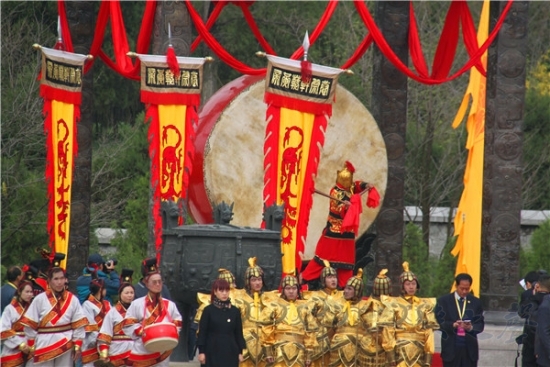
Then Chen Zhu, the vice chairman of the Standing Committee of the National People's Congress, Liu Qibao, the vice chairman of the Chinese People's Political Consultative Conference (CPPCC), and Hong Xiuzhu, the former chairman of the Kuomintang of China, consecrated flower baskets to the Yellow Emperor.
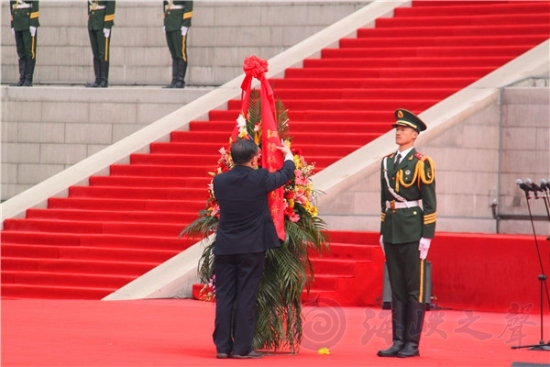
Chen Zhu, the vice chairman of the NPC Standing Committee, consecrated the flower basket.

Liu Qibao, the vice chairman of the CPPCC, consecrated the flower basket.
Hu Heping, the secretary of the Shaanxi Provincial Party Committee, Liu Jieyi, the director of the Taiwan Affairs Office of the State Council PRC, and Xu Yousheng, the director of the Overseas Chinese Affairs Office of the State Council, on behalf of the CPC Shaanxi Provincial Committee, the Provincial People’s Congress Standing Committee, the provincial government, the provincial CPPCC, and all sectors of Shaanxi as well as the organizers consecrated flower baskets.
Representatives from all walks of life also consecrated flower baskets respectively. There were representatives of central and state organs, democratic parties and people's organizations; representatives from provinces and regions; representatives from Hong Kong and Macao compatriots and overseas Chinese; Yu Muming, the People’s New Party Chairman, together with Taiwanese youth representatives; representatives of the national moral models, model workers, models of the time, March 8th red-banner pace-setters, outstanding youth, excellent scientific and technological workers; representatives of the Olympic Winter Games Administration; and representatives of the Mausoleum guards.
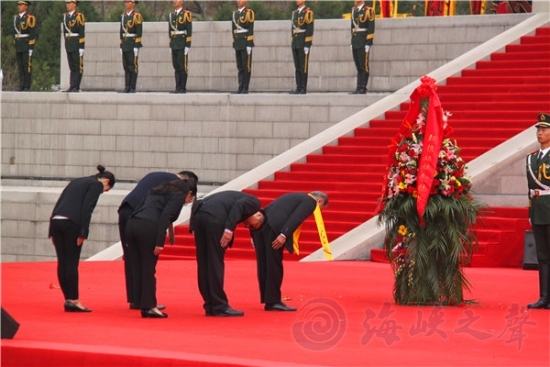
Yu Muming, the chairman of the People’s New Party, together with Taiwanese youth representatives consecrated the flower basket.
After the elegiac address by Liu Guozhong, the governor of Shaanxi Province, all participants bowed three times, paying honor to the ancestor of the Chinese civilization.
Seeking the root: engraving the precious memories
During the Tomb Sweeping Day holiday, it is a thousand-year-old and everlasting traditional event to hold the public memorial ceremony for the Holy Ancestor, the Yellow Emperor, allowing the Chinese nation to seek out its root. This tradition represents the worship of the Chinese history as well as the strong cultural confidence of the Chinese people at home and abroad, through which they pass on the Chinese cultural gene, show the glamorous culture, stimulate their patriotism and intensify the national senses of belonging and identity. For thousands of years, whether the members of the royal families or the ordinary folks, all Chinese people unanimously respect the Yellow Emperor as the common ancestor to bow in worship to, regardless of the regions and parties.
During the Tomb Sweeping Day holiday, every year people from both sides all inherit the shared historical and cultural memories as well as the blood in a ritualism way. On this Tomb Sweeping Day, more than 200 Taiwan compatriots from all walks of life took part in the Public Memorial Ceremony for the Yellow Emperor.
Yu Muming, the chairman of the People’s New Party in Taiwan, has attended the Public Ceremony on many occasions. He said, “I come here to worship our Holy Ancestor every year. We should forever cherish the bliss and heritage left by our ancestors.” In order to appreciate the bliss endowed by the ancestors, he took some younger friends from Taiwan here this time to personally experience the history that they had never seen in the textbooks, hoping it would engrave deep memories in their life.
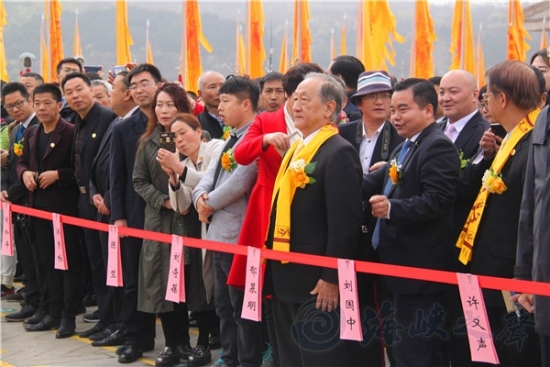
Yu Muming, the chairman of the People’s New Party in Taiwan
It was the first time that 17 students and 4 teachers from Jinou Girls High School, Taipei, attended the public memorial activities in Xi’an. After the ten-day trip, they witnessed the culture and landscapes of the ancient city of Xi’an and learned about the prosperity of China's mainland as well. The school principal Wang Weimin hoped that his students could profoundly understand the Chinese history and enhance the national sense of identity.
Lai Chunliang, a student from Jinou Girls High School, expressed that the opportunity to join in the public memorial activity was really hard to win. Being a part of the history that one previously learned about only in textbooks while being nurtured by the traditional culture would help her a lot in life. In addition, she was deeply fond of the architecture in Xi’an that combined both ancient and modern styles. After going back to Taiwan, she’d like to share these firsthand experiences with her friends.
The Grade Two student Li Wanyu found that China's mainland was different from what she thought, and she was very happy to enrich her experience and knowledge through this trip. Li said that she would continue to follow the development of China's mainland, and she would like the opportunity to study in China's mainland to broaden her horizon in the future.

Li Wanyu, a student from Jinou Girls High School, Taiwan
The ritual dance: Highlights of the public memorial ceremony
The ritual dance is an important element in Chinese culture. This year the ritual dance consisted of four sections: “Overture”, “Ritual Music”, “Cloudland” and “Dragon Dance”. The dances were performed in accordance with the “Bayi” standard for the national rituals, which means every segment of the dances were divided by eight, namely a dance of 64-people or 32-people.
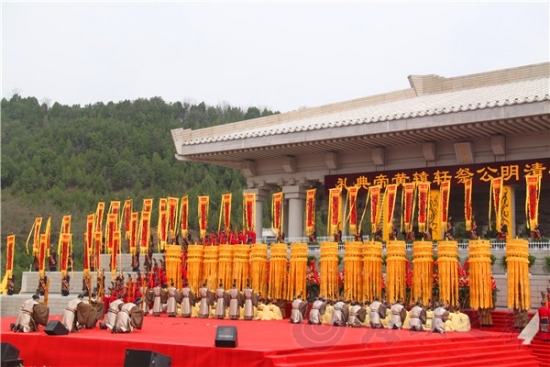

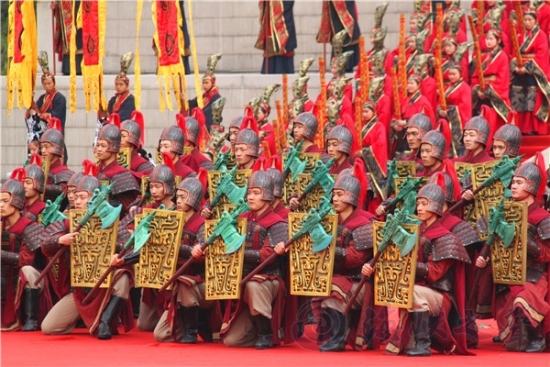
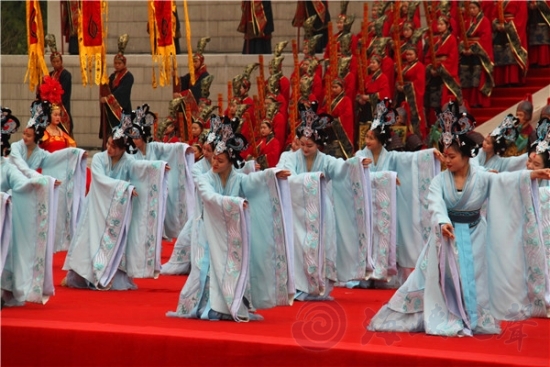
The “Dragon Dance” was the most wonderful section in this part. With the drumming, a 56-meter-long artificial “Chinese Dragon” came on the stage, spiraling and flying above people, rising up to the sky, demonstrating the legendary myth where the Yellow Emperor rode a dragon at Mount Qiaoshan flying to the heaven. Dragon, Long in Chinese, is the symbol of the Chinese national spirit. A well-known ancient Chinese poet Fan Zhongyan had even depicted this grand picture in his poem.

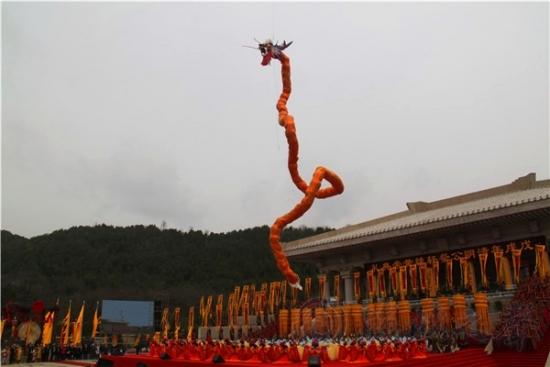
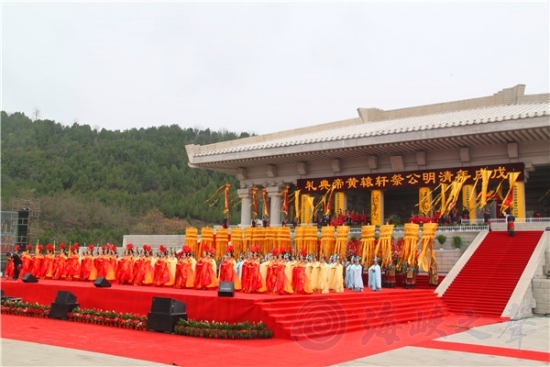
At the end of the ceremony, the participants were worshiping at the Xuanyuan Palace and at the Mausoleum of the Yellow Emperor.
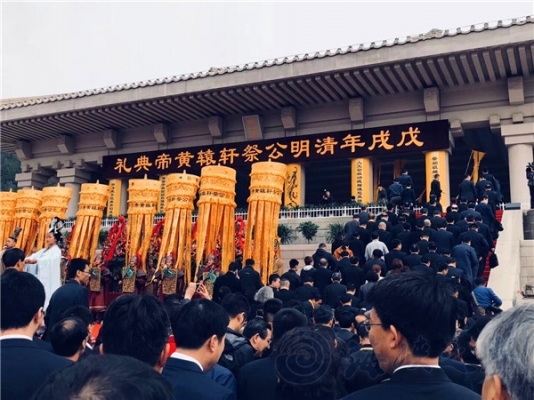

Hong Xiuzhu, the formal President of China’s Kuomintang
Remembering the origin and preserving the root
After the ceremony, compatriots from Hong Kong, Macao and Taiwan as well as overseas Chinese took part in the activity of tree planting, which was co-organized by the Taiwan Affairs Office of the State Council PRC, the Overseas Chinese Affairs Office of the State Council and other related departments, in order to build the “Overseas Chinese Forest”, the “Forest of Descendants of the Yan Emperor and the Yellow Emperor”, the “Origin Remembering Forest” and the “One Heart Forest” at Mount Qiaoshan.
The activity to build the “Origin Remembering Forest” was initiated by Yu Muming, the chiarman of the People’s New Party in Taiwan. Liu Jieyi, the director of the Taiwan Affairs Office of the State Council PRC also participated in it.
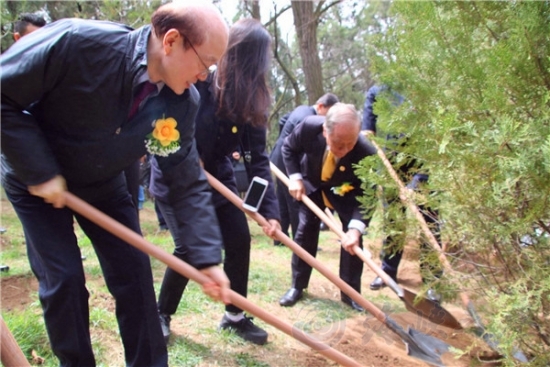
Liu Jieyi, the director of the Taiwan Affairs Office of the State Council PRC, was planting trees with Yu Muming, the chairman of the People’s New Party in Taiwan.
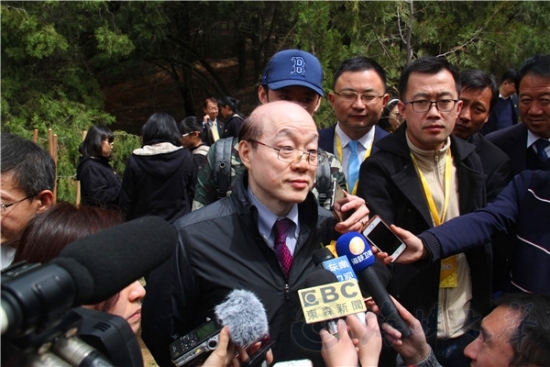
Liu Jieyi, the director of the Taiwan Affairs Office of the State Council PRC.
Director Liu told the reporters that he had ever participated in many trees-planting events before, but this time the event had an in-depth meaning. He said: “The Mausoleum of the Yellow Emperor is a spiritual symbol of our Chinese civilization. Today, compatriots from both sides along the Taiwan Strait are planting trees together, recollecting the ancestor of the Chinese nation and advancing the spirit of Chinese culture. With careful cultivation, the trees we plant today will grow into big and strong ones, indicating that the shared wishes and the joint effort of the compatriots from China's mainland and Taiwan will develop steadily.” He appealed to people from both sides to carry forward the Chinese culture, concentrate on the Chinese spirit, reach a more ideal consensus and make joint efforts for the great rejuvenation of the Chinese nation.
Now there are over 80,000 cypress trees growing here since the first cypress was planted by the Yellow Emperor at Mount Qiaoshan. Planting trees for forestation has been a good tradition of the Chinese nation passed on through generations, becoming the symbol of the bond that connects all Chinese people around the world. Planting trees at the Mausoleum of the Yellow Emperor located at the top of Mount Qiaoshan is in the hope that all Chinese people could plant their roots in this land and carry them on.



